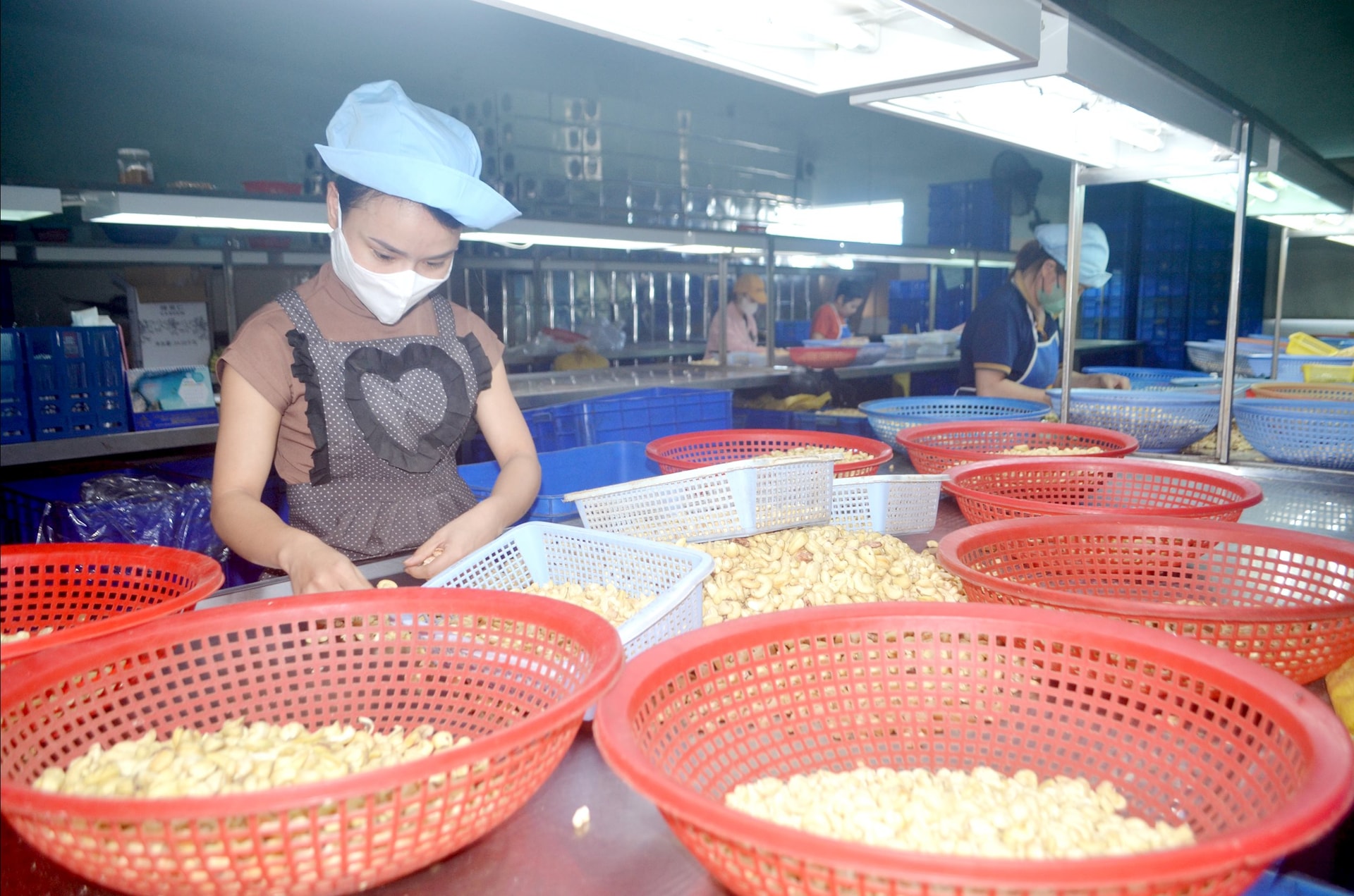
Expect stable growth
According to the Vietnam Cashew Association (Vinacas), the average export price of cashew nuts in the first 7 months of 2025 is estimated to reach 6,805 USD/ton, an increase of 21.4% over the same period in 2024.
In the context of a volatile global market, cashew export prices have increased sharply, opening up a promising period of prospects for this key agricultural product.
This is a positive signal, encouraging businesses and individual production facilities, cashew growers to focus on improving output, quality, and restructuring the cashew industry according to sustainable value chains. Ms. Hoang Thi Dieu's family, village 5, Cu Jut commune has 1.8 hectares of cashew cultivation.
According to Ms. Dieu, 20 years ago, her family bought the above land and decided to grow cashews, because they found the land was not fertile and irrigation was not convenient. The land the family cultivated had a large slope, about 45%, the soil was quite poor, so the family decided to grow cashews.
Fortunately, the tree still grows normally despite little care. Every year, she takes care of the cashew garden 1-2 times with some activities such as: fertilizing, cutting off diseased branches, and weeding.
The cashew garden used to give her a fairly high income in good years, for example in 2015 - 2017, she harvested nearly 4 tons, with a selling price of 32 million VND/ton, earning nearly 128 million VND, after deducting expenses, she also achieved a profit of about 40 million VND/ha.
However, in the past 5 years, cashew trees have been affected by the weather, causing them to flower but have difficulty setting fruit. Pests such as stink bugs and stem borers have caused a lot of damage, so income has decreased.
However, her family is still attached to the cashew garden. Every year, with sick and old trees, she destroys them and replants some grafted cashew varieties. In the first months of 2025, when the price of cashew nuts is quite stable, she hopes to have the opportunity to increase income and stably develop the cashew garden.
Among them, what she wants most is to have a breed that is suitable for the current climate change.
Mr. Nguyen Thanh Nam, Bon Philate, Quang Tan commune, who has been attached to cashew trees for over 20 years, confided that at one time it could be said that his family was well-off thanks to cashew trees.
His family's 10-hectare pure cashew orchard produces high-quality fruits and earns hundreds of millions of dong each year. But now, the area is only over 2 hectares. He believes that in order for cashew trees to develop sustainably, people, especially poor households and ethnic minorities in disadvantaged areas, need timely guidance in preventing and controlling seasonal pests and diseases of cashew trees.
Mr. Nam emphasized that more importantly, the functional sector and local authorities must control the quality of seedlings. New cashew varieties and grafted cashews grow quickly, produce many large fruits, and produce good seeds, but if the varieties are not guaranteed and people buy them from unknown sources, they will lose both money and health.
Restructuring along the value chain
As a unit that has produced and exported cashew nuts directly to the Chinese market for many years, Ms. Nguyen Thi Minh Nguyet - Director of Hong Duc Company Limited, Kien Duc commune, commented: 2025 continues to be a year of cashew exports with a rise in value.
This is due to many factors, one of which is the growing trend of healthy snacking globally, causing consumers to pay more attention to nutritious, health-beneficial nuts. Ms. Nguyet believes that in order to restructure the cashew tree sustainably, we must first think about the factors in the value chain.
In particular, people need to change their perception of the role of cashew trees. This is a tree that can bring in quite a high income if well cared for. People need to change their perspective, from considering cashew a secondary crop to a main crop, investing in fertilizers, and effectively preventing pests and diseases. Along with that, there must also be innovation in harvesting. That is, harvesting at the right time, so that the cashew nuts have the best quality, which is the basis for increasing the selling price. Her processing enterprise still has a very large demand for input materials.
Some opinions also said that the provincial agricultural and environmental sectors need to have a comprehensive re-evaluation of the development of cashew trees on a provincial scale. From there, correctly assess the reality, closely assess the challenges from objective factors such as natural disasters, weather. The province needs to plan specific and clear production areas for each locality, suitable for each cashew variety as a basis for developing into a concentrated raw material area, investing in deep processing according to the value chain...
It is known that to take advantage of the potential of the cashew industry, functional sectors such as agriculture, industry and trade, and provincial associations are strengthening cooperation, supporting businesses in processing and trading cashew products to diversify products, deep processing to increase value, and promote OCOP products from cashew nuts.
The province promotes the application of e-commerce, promotes, advertises and helps Lam Dong cashew industry easily access the world market.
The whole province currently has 49,200 hectares of cashew, of which the business area is 48,700 hectares, the cashew trees have completed harvesting with an output of over 35,800 tons, equivalent to 85.5% of the plan set for 2025.
Source: https://baolamdong.vn/co-hoi-tai-co-cau-cay-dieu-ben-vung-389878.html




![[Photo] Politburo works with the Standing Committee of the Party Committee of the Fatherland Front and Central organizations](https://vphoto.vietnam.vn/thumb/1200x675/vietnam/resource/IMAGE/2025/9/4/6f23e5c0f576484bb02b3aad08f9d26a)
![[Photo] Prime Minister Pham Minh Chinh chairs the thematic meeting on law making in August 2025](https://vphoto.vietnam.vn/thumb/1200x675/vietnam/resource/IMAGE/2025/9/4/ba42763cd48e4d7cba3481640b5ae367)



































































































Comment (0)